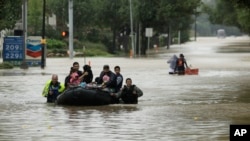United Nations climate experts say the warming of the planet is endangering the Gulf of Mexico, and all the life and business it supports.
The Intergovernmental Panel on Climate Change, known as IPCC, recently released a report on the health of the Earth. It says even if humans work together to limit global warming, sea levels will rise, fish populations will decrease and harmful algae blooms called toxic tides will become more frequent.
“South Louisiana is probably the most vulnerable place to climate change in the United States,” says Barry Keim, a climate scientist for the state of Louisiana. He agreed with the IPCC finding that hurricanes, floods and other extreme weather will increase in number and power.
Keim said the usual hurricanes in the area “can bloom up into major hurricanes.”
The report notes U.S. efforts in some cities to build sea walls, high roads and take other measures to meet rising waters. But, the report says officials in the southeastern U.S. have not ordered limits on industrial pollution.
Just last week, leaders in Florida chose not to add clean energy plans to a bill that is supposed to protect the state from increased flooding.
Ben Diamond is a state lawmaker in St. Petersburg, Florida. He is running for a position in the U.S. Congress. He said it is good lawmakers want to work on ways to deal with violent weather. But, he said they also need to stop “the causes of those problems,” like reducing greenhouse gas and carbon emissions.
The IPCC report says that people in Florida are now looking to move homes far from the coast. That is different than in the past. The report noted that the area around Miami already has floods even when there is no rain, and the area around the large Florida city of Tampa has a flood risk due to high water levels when there are storms in other parts of the Gulf.
Keim, in Louisiana, said the area where the Mississippi River meets the Gulf is also at risk. He said building related to the oil and gas businesses in the area has hurt the area’s ability to manage floods.
The IPCC also says that parts of the Gulf with economies based on tourism will be in trouble due to warming water. For example, visitors like to explore the ocean waters on the Gulf side of Florida and the resorts of Mexico’s Yucatan peninsula. However, the coral reefs that keep the sea life healthy in those areas are dying because of warming water. If the reefs are not able to survive, it would cost Florida’s economy tens of billions of dollars by the year 2100.
The IPCC report notes what some cities are doing to adapt to climate change. For example, the city of Miami Beach already spent $500 million on pumps that can move water off the island.
Alex Kolker studies the coastline for a group of Louisiana universities. Kolker noted that the state recently announced a plan to reduce polluting gases by 2050. The U.N. said the state has projects in place to deal with flooding and rising sea levels.
Throughout the southeastern U.S., states are reporting a rise in the number of red tides. Red tides happen when warmer water allows dangerous organisms to grow. The tides kill fish and other sea life, and cause bad smells that keep people away from popular beaches.
A study by the University of Florida showed that between 2017 and 2019, the state’s economy lost over $180 million because of red tides. The warmer water also hurts large sea animals called manatees. Manatees eat seagrass, which can be overtaken by algae which grows easily in warm water. One group started feeding manatees lettuce instead.
I’m Dan Friedell.
Dan Friedell adapted this story for Learning English based a report by The Associated Press.
What do you think the U.S. and Mexico can do to help the waters of the Gulf of Mexico become healthier? Write to us in the Comments Section and visit our Facebook page.
Words in This Story
bloom – n. a mass of planktonic algae in lakes, ponds, or the sea, as in the development of red tides
toxic – adj. containing poisonous substances
tide– n. the regular upward and downward movement of ocean levels due to the pull of the sun and moon on the Earth
vulnerable – adj. easily hurt or harmed
greenhouse gas – n. gases like carbon dioxide and methane that trap heat in the atmosphere and warm the planet
emissions – n. something being sent out or given off
coral reef – n. the material formed on the bottom of the sea from the skeletons of small creatures that is home to many living things, such as sea plants and fish
algae –n. simple plants that grow in water and can overtake other sea life











